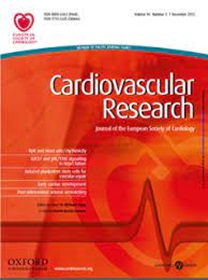NRF2 activation in the heart induces glucose metabolic reprogramming and reduces cardiac dysfunction via upregulation of the pentose phosphate pathway
IF 10.2
1区 医学
Q1 CARDIAC & CARDIOVASCULAR SYSTEMS
引用次数: 0
Abstract
Aims The transcription factor NRF2 is well recognized as a master regulator of antioxidant responses and cytoprotective genes. Previous studies showed that NRF2 enhances resistance of mouse hearts to chronic hemodynamic overload at least in part by reducing oxidative stress. Evidence from other tissues suggests that NRF2 may modulate glucose intermediary metabolism but whether NRF2 has such effects in the heart is unclear. Here, we investigate the role of NRF2 in regulating glucose intermediary metabolism and cardiac function during disease stress. Methods and Results Cardiomyocyte-specific Keap1 knockout (csKeap1KO) mice, deficient in the endogenous inhibitor of NRF2, were used as a novel model of constitutively active NRF2 signaling. Targeted metabolomics and isotopomer analysis were employed in studies with 13C6-glucose in csKeap1KO and wild-type (WT) mice. Pharmacological and genetic approaches were utilized in neonatal rat ventricular cardiomyocytes (NRVM) to explore molecular mechanisms. We found that cardiac-specific activation of NRF2 redirected glucose metabolism towards the pentose phosphate pathway (PPP), a branch pathway of glycolysis, and mitigated pressure overload-induced cardiomyocyte death and cardiac dysfunction. Activation of NRF2 also protected against myocardial infarction-induced DNA damage in remote myocardium and cardiac dysfunction. In vitro, knockdown of Keap1 upregulated PPP enzymes and reduced cell death in NRVM subjected to chronic neurohumoral stimulation. These pro-survival effects were abolished by pharmacological inhibition of the PPP or silencing of the PPP rate-limiting enzyme glucose-6-phosphate dehydrogenase (G6PD). Knockdown of NRF2 in NRVM increased stress-induced DNA damage which was rescued by supplementing the cells with either NADPH or nucleosides, the two main products of the PPP. Conclusions These results indicate that NRF2 regulates cardiac metabolic reprogramming by stimulating the diversion of glucose into the PPP, thereby generating NADPH and providing nucleotides to prevent stress-induced DNA damage and cardiac dysfunction.NRF2在心脏中的激活诱导葡萄糖代谢重编程,并通过上调戊糖磷酸途径减少心功能障碍
目的转录因子NRF2是公认的抗氧化反应和细胞保护基因的主要调控因子。先前的研究表明,NRF2至少在一定程度上通过减少氧化应激来增强小鼠心脏对慢性血流动力学过载的抵抗力。来自其他组织的证据表明,NRF2可能调节葡萄糖中间代谢,但NRF2是否在心脏中有这种作用尚不清楚。在此,我们研究了NRF2在疾病应激过程中调节糖中介代谢和心功能的作用。方法和结果心肌细胞特异性Keap1敲除(csKeap1KO)小鼠缺乏内源性NRF2抑制剂,被用作组成型活性NRF2信号传导的新模型。在csKeap1KO和野生型(WT)小鼠的13c6 -葡萄糖研究中采用了靶向代谢组学和同位素分析。采用药理学和遗传学方法探讨新生大鼠心室心肌细胞(NRVM)的分子机制。我们发现NRF2的心脏特异性激活将葡萄糖代谢重定向到戊糖磷酸途径(PPP),这是糖酵解的一个分支途径,并减轻压力过载引起的心肌细胞死亡和心功能障碍。NRF2的激活还可以防止心肌梗死引起的远端心肌DNA损伤和心功能障碍。在体外,敲低Keap1可上调PPP酶,减少慢性神经体液刺激下NRVM的细胞死亡。通过药物抑制PPP或沉默PPP限速酶葡萄糖-6-磷酸脱氢酶(G6PD),这些促进生存的作用被消除。NRVM中NRF2的敲低会增加应激诱导的DNA损伤,这种损伤可以通过补充NADPH或核苷(PPP的两种主要产物)来修复。结论NRF2通过刺激葡萄糖向PPP转移来调节心脏代谢重编程,从而产生NADPH并提供核苷酸以防止应激诱导的DNA损伤和心功能障碍。
本文章由计算机程序翻译,如有差异,请以英文原文为准。
求助全文
约1分钟内获得全文
求助全文
来源期刊

Cardiovascular Research
医学-心血管系统
CiteScore
21.50
自引率
3.70%
发文量
547
审稿时长
1 months
期刊介绍:
Cardiovascular Research
Journal Overview:
International journal of the European Society of Cardiology
Focuses on basic and translational research in cardiology and cardiovascular biology
Aims to enhance insight into cardiovascular disease mechanisms and innovation prospects
Submission Criteria:
Welcomes papers covering molecular, sub-cellular, cellular, organ, and organism levels
Accepts clinical proof-of-concept and translational studies
Manuscripts expected to provide significant contribution to cardiovascular biology and diseases
 求助内容:
求助内容: 应助结果提醒方式:
应助结果提醒方式:


